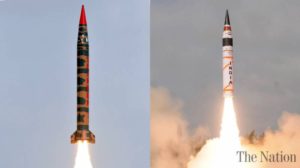
by Ahyousha Khan
In April 2017, India announced its Joint Military Force Doctrine to counter “full spectrum of Military Conflicts.” One of the significant developments in this doctrine is Indian infatuation of “surgical strikes” with the usage of this term first time in September 2016. It was claimed that surgical strike strategy was opted to counter terrorism. Last year, India trumped the card that it has managed to launch a successful surgical strike near LoC and Pakistan denied that claim and declared it cross-border firing.
For quite long, India had no answer to the threat of terrorism but to rely on diplomatic maneuvering. However, the surgical strike was only fake capsule to manage the pressure of Indian people implying that their state is not sitting idly in response to so-called Pakistani sponsored terrorism.
The fact must be noted that surgical strike is military action involving air strike; it is required to be conducted with efficiency, precision and the element of surprise in it. This fact has been asserted by various national and international security personalities and scholars. On the other hand, Indian gave a slightly different definition of what it considered as a surgical strike; it is a military action done by forces with lightning speed to hit and destruct enemy’s installation and coming back to the same position.
By considering the option of the surgical strike as an effective response to terrorist activities India has created an option for itself in response to threats it is facing. Consideration of surgical strikes as a viable option, somehow, signifies the development of surgical strike as an answer to sub-conventional threats on the part of India. At the same time, this action has generated a debate that whether nuclear deterrence will be affected or it will remain the same.
Deterrence is something that halts enemy not to be ambitious for launching an attack and threats are delivered with a focus that such desires will not be met to end without heavy-costs. Since I998 India and Pakistan are practicing an arduous task of deterrence and are constantly involved in an arms race to manage their security dilemmas.
Since nuclearization of South Asia, Pakistan is trying to mitigate the effects of Indian non-conventional military build-up to secure some nuclear equilibrium. It can be claimed to a certain extent that nuclearization and deterrence have helped India-Pakistan to avoid complete extinction of each other.
However, deterrence has virtually failed on lower levels of strategic stability. The absence of deterrence stability at more moderate levels has created adequate space for both rivals to contest each other. Surgical strike and it’s so-called use to counter terrorism is also Indian attempt to exploit the gap below the nuclear threshold.
Therefore, immediate concerns rise how manipulations in such a way can escalate the conflict.
Pakistan is a relatively smaller state than India. Its military budget is less than Indian military budget. India is likely to spend 2.94 trillion in contrast to Pakistan who will spend additional 10 percent of its existing budget of 920.2 billion. Indian conventional superiority is a perceived threat to Pakistan and Pakistan is relying on its deterrence capability of nuclear arsenals as a counter strategy to this threat.
Apparently considering a surgical strike as an option, India is challenging the effectiveness of Pakistan’s nuclear deterrence. India is posing as a launch of nuclear weapons is a tough decision for Pakistan, and in this way, India may exploit the gap below the nuclear threshold. By doing so, India is also undermining the logic of rationality and fear that are guiding principles of deterrence discourse. Deterrence cannot work in an environment where nuclear rivals don’t even consider the rationale behind holding on considering the consequences.
Even though what India declared as the surgical strike was nothing but a false claim, Pakistan is not at liberty to think that same kind of border skirmish will be declared as a surgical strike in future. With robust military and conventional capabilities, India might consider launching an attack. Furthermore, conflicts below nuclear threshold do have potential to escalate into nuclear conflict, In that case, will deterrence be effective? Or is it alright by India to keep exploiting levels below the nuclear threshold? As a countermeasure, it is necessary for Pakistan to strengthen its deterrence capability.
As now India has entailed this term in its official doctrine. Pakistan needs to take certain measures. First and foremostly, the conventional military build-up is the necessity of time, and conventional deterrence is unavoidable to tackle enemy like India. With recent developments in India and support of the International community for India would not help Pakistan to rely on nuclear deterrence. Indian access to MTCR is also a threat to deterrence stability. Owing to this fact, India will be able to access the technology like-cryogenic engines, predators’ avenger’s drones, arrow theatre missile defense interceptors so on that can also facilitate Indian dream of surgical strikes.
Secondly, Pakistan needs the procurement of fissile material to fulfill its growing domestic and military needs. Especially after the Indo-US deal, Indian fissile material resources are increasing. According to a report published by Harvard University “Indian Nuclear Exceptionalism,” India can produce 2200 nuclear weapons. By having access to fissile material Pakistan would be able to maintain deterrence as we know it, otherwise, the disparity will change strategic equilibrium in South Asia. Thirdly, Pakistan needs to increase its surveillance capabilities, early warning capabilities and need to invest in UAV technology.
Lastly, to ensure deterrence it is necessary that state should not only develop credibility but develop a mechanism to communicate it as well. Therefore, surgical strikes have enough potential to pose future challenges for Pakistan in the given conventional and deterrence environment.
